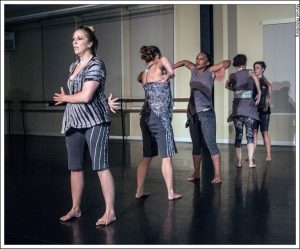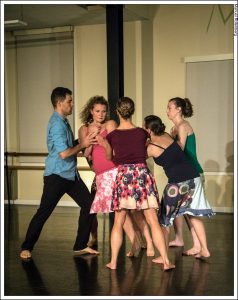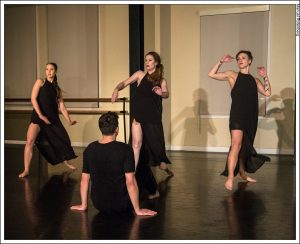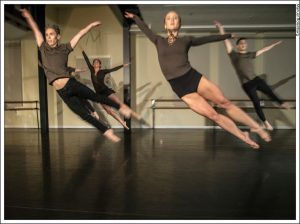Show Gives “Propulsion” to New Dancemakers, New Audiences
Propulsion is the act of driving or pushing forward, and that’s what Malashock Dance did in “Propulsion,” a showcase for work by four young company members. Presented last weekend at Malashock’s Abbe Wolfsheimer Studio, the high-energy program featured two dances each by Andrew Holmes, John Paul Lawson, and Lara Segura, and one by Blythe Barton.

“Umbrage.” Photo: Manny Rotenberg
Barton, who has her own company and regularly does full-evening shows, is the most established of the four. Her visceral, urgent “Umbrage” (2011) is a knockout—almost literally, as five women fiercely grapple with one another. In a fabulously tense faceoff, Anne Gehman and Cecily Holcombe are like boxers, staggering apart for a moment, then flinging themselves back into the ring; the other three dancers hover in the opposite corner, a smart use of space by a dancemaker with a sharp, exciting choreographic intelligence.

“NRE & Other Issues.” Lindsay Martin in pink. Photo: Manny Rotenberg
As a performer, Lara Segura brings exquisite expressiveness to John Malashock’s psychologically thorny dances, in which relationships can be a minefield. There’s a similar depth and ambiguity in Segura’s pieces here, a longing to connect yet a fear of intimacy. In “NRE & Other Issues” (2016), the title refers to “new relationship energy,” and there are moments of happy dancing, for instance, a lively bit like a hoedown. Often, though, the six dancers’ smiles look forced. A central character, Lindsay Martin, casts wary glances as she’s surrounded by the others and tilts off-balance into them, in an uneasy trust circle. And, at the end, Martin stands alone.
Segura’s “Cracked and Breaking” (2012), opens with Rachel Torres standing at the front of the stage and inviting our gaze … but also avoiding it, her eyes downcast, one hand circling her head like a mosquito. In a vivid solo, Torres runs frantically in all directions, becomes fascinated with her fingers, reaches as if measuring space. And she seems to find no comfort when Brianna Bellamy and Molly Schwartz join her, sometimes moving in unison, although this part of the piece didn’t cohere for me—maybe at this point, she’s broken into several pieces?

“Red.” Photo: Manny Rotenberg
Andrew Holmes made “Crysis” (2011) when he was twenty-one, and an opening solo in which June Ting throws himself around has the youthful feel of emoting in one’s bedroom. But the piece gets more interesting, with quick changes of level and direction, when five women appear.
And in Holmes’s premiere, “Red,” he deftly uses space. Three women and a man connect and part, approach an invisible center line but fall back as if magnetically repulsed, and dash across the width of the stage. When it comes to meaning, though, I felt this piece needed development. In the program notes, Holmes quotes Emma Watson on opposing gender stereotypes. But, as the man (Lawson) partnered and abruptly left each woman—and later they seemed to bond against him—I sensed a story in which he was a cad who played the women, but then they got revenge.

“Running.” John Paul Lawson is on the right. Photo: Manny Rotenberg
Lawson has a strong ballet background, and it was gloriously evident in his premiere, “Running,” and a 2015 piece, “Dusk to Dawn.” Dancers pirouetted, partnered, leapt, and did joyous arabesques—none more than Lawson himself, whose exuberant grin could have powered Point Loma. “Dusk to Dawn” even ended with a Paul Taylor moment, the dancers in a tight circle reaching to heaven. Both of these short pieces felt like Lawson was just letting loose with his ballet chops; I’d like to how he handles the demands of a longer dance.
Along with enjoying the action onstage, I was delighted to see the audience on Saturday. They were young, and—unlike my experience at most dance shows—I didn’t know any of them. That’s one of the beauties of a show like “Propulsion.” It cultivates new dance fans.
